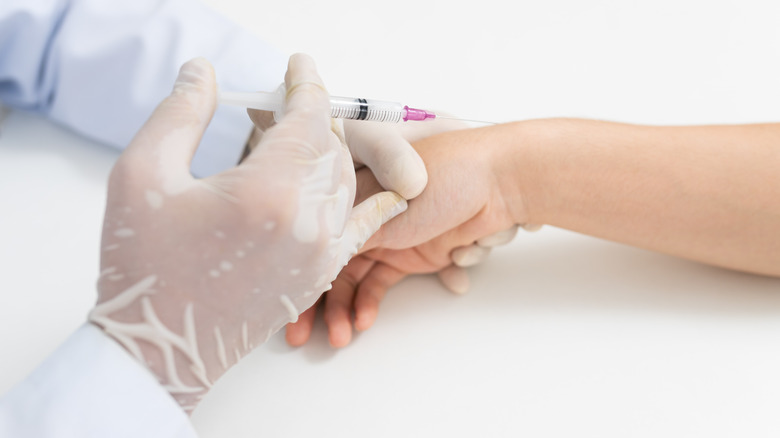A Simple Saline Injection May Become A New Treatment Option For Carpal Tunnel Syndrome
Carpal tunnel syndrome occurs when a nerve located in the carpal tunnel at the base of your hand, is compressed by surrounding ligaments and bones. Symptoms can include finger swelling and numbness and the intensity can vary depending on how severe the condition is, per the National Institute of Neurological Disorders and Stroke (NINDS). Experts believe it may be aggravated by several factors that include an injury, trauma, fluid retention, or rheumatoid arthritis. That said, there appears to be no single cause for it. Women are also more likely to develop carpal tunnel syndrome.
Treatments for this condition vary depending on the severity of symptoms. Nonsurgical treatments include wearing a wrist splint, taking over-the-counter pain medications, and corticosteroid injections (via Mayo Clinic). Sometimes surgery is warranted when other methods don't work. Now, a new study suggests that saline injections may be enough to eliminate the pain caused by carpal tunnel syndrome.
The procedure requires little downtime
The study, published in the journal Radiological Society of North America, describes how a treatment called hydrodissection could help those with carpal tunnel syndrome. For their study, researchers divided 63 participants into three groups: one group received hydrodissection with a saline injection, the second group received hydrodissection and an injection mixture of saline and corticosteroid, and the third group was injected with a corticosteroid.
Participants were followed up with at the one, three, and six-month mark after treatment. At the end of four weeks, all participants reported less pain. By the 12-week and six-month mark, the groups that received hydrodissection showed greater improvement, but those who received a corticosteroid injection reported their symptoms returned. Co-author of the study, Anupama Tandon, says that the results were a "pleasant surprise," adding that the procedure is low-cost, minimally invasive, and requires little downtime. Comparatively, the internal healing time for surgery can take several months, the Mayo Clinic reports.


